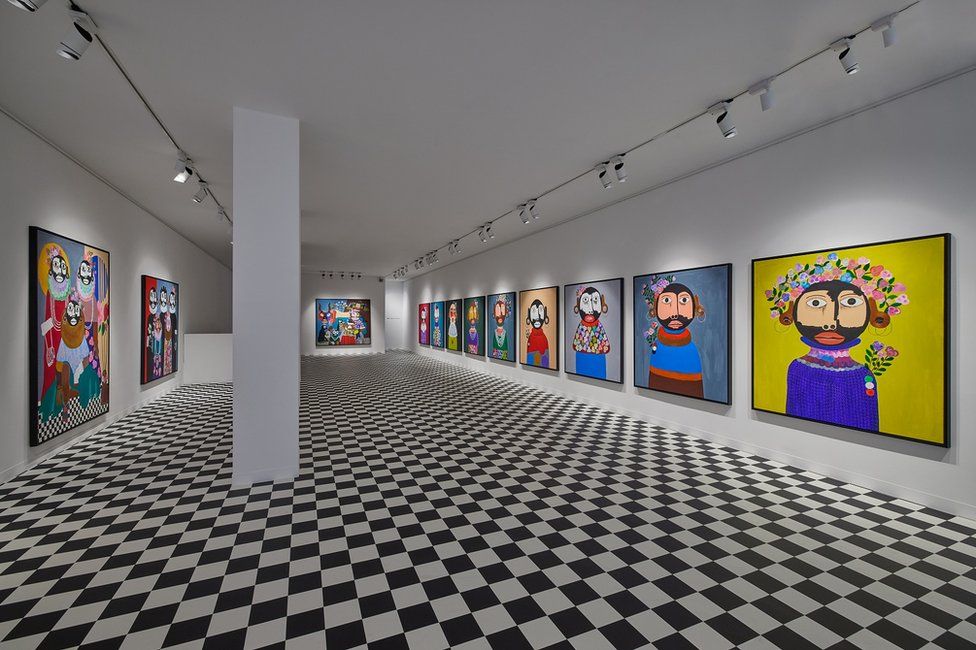
Kojo Marfo, a Ghanaian butcher turned painter is determined to let the world know about the importance of cows.
“The cow builds civilizations,” says Marfo. “In Ghana we use them to plough the land and if you have two to three animals, you can get a beautiful woman to marry you. In parts of India they are treated as Gods.”
Marfo’s deep attachment to cows was influenced by his childhood encounters whiles growing up in the mountainous region of Kwahu, a town located in the Eastern part of Ghana. He lived with his mother and grandmother prior to his relocation to the United states of America.
His enthusiasm about cows grew after he settled in New York city for work and had to fall into a short-term career as a butcher. “I was actually hopeless. I knew so little about meat, I’d cheat,” says Marfo.
“On the wall there were anatomical drawings of the animals detailing each cut and I’d have to use those as a guide. Even then, my boss would catch me and all I would be doing is chatting to customers,” he added.
Marfo may have once vended the flesh, but now his cattle-inspired paintings earns him three times his offer price. The work of 41-year old Kojo Marfo, now graces a range of designer scarves and shawls by Aspinal of London.
Marfo’s other interests in the power of womanhood, the value of single parenting and the beauty of vitiligo can be vividly seen in his artworks.
Even though he grew up in Ghana, Kojo Marfo’s paintings does not only identify with only Ghanaians or Africans but each piece is a beautiful makeshift of different continents. Among his many paintings on the culture of a people are the, renaissance ruff collars from Britain, sacred cows from India and fertility dolls from Ghana.
“We live in a great melting pot – it has many cracks in it,” he says. “But I want to bring people together and for everyone to see their culture reflected.”
To Marfo painting just a beautiful art is not want inspires him but the power of his art to communicate to people in different ways, – art should speak to the soul of its lovers, says Marfo.
Marfo recalls spending his childhood days in the local library, looking at pictures of Picasso and watching the craftsmen of Accra sell their wares to tourists, but that did not influence him to start a career in painting.
“I felt I should be a doctor or an accountant, but I would go to the river’s edge and collect the tough clay or get berries and crush them into dyes.
“I would put Vaseline on paper to create tracing paper to trace from art books or magazines. But it wasn’t until I left Ghana that my work became serious.”
After spending some years in New York, Marfo moved to the UK to become a grocery attendant in his auntie’s store.
At this time, Marfo had lost inspiration in the arts and had taken a break from painting. He was drawn back into the painting when recounting on his childhood memories as a young boy in a cattle rearing town who was raised by two strong women.
“In the mountains, women are the hardest-working people there and women alone raised me. A staunch feminist once told me that men were always in charge, that women were always victims. But women are always in charge where I’m from.”
His work also began to play with ideas of beauty – giving all his characters vitiligo on their faces. The medical condition sees paler, unpigmented patches develop on a person’s skin.
Kojo Marfo began selling his pieces online and also sent the pieces to an open call-out for emerging artists, called Isolation Mastered.
The judges at the event, which included Sotheby’s art historian, David Bellingham and art collector, Gavin Rossdale, were attracted to the vibrancy and edge of Marfo’s artwork.
Rossdale’s purchase of Marfo’s painting for his personal collection opened a lucky streak for the budding artist. Marfo’s collections suddenly welcomed numerous buyers.
At his first exhibition at London’s JD Malat Gallery, all of his works sold out in the first month. At his second exhibition, Dreaming of Identity, all of his works were bought by the end of the first day.
“I hear two things from buyers: They see something different in my work – ‘there’s no-one doing what you’re doing,’ they say – and they like the personal stories I attach to them.”
In spite of his many successes, Marfo has not written off the possibility of returning to butchering.
“I am still fascinated by the work of butchers, I’d like to learn the skill and do it properly.”
Source : BBC
